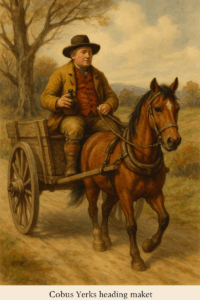From The Book of Saint Nicholas, and the Dutch-American Legacy of the Yerks Family
In my continued research into the Yerks family line, I recently rediscovered a remarkable short story called “Cobus Yerks”, originally published in The Book of Saint Nicholas: Translated from the Original Dutch of Dominie Nicholas Aegidius Oudenarde. While the book is presented as a “translation,” it is, in fact, an early 19th-century collection of humorous and nostalgic tales set in the Dutch-American communities of the Hudson River Valley—written in the style of Washington Irving and his contemporaries.
The story is fictional. But I believe it is clearly inspired by real people, places, and family lore—specifically, our own Yerks ancestors.
The Family Connection
The main character, Cobus Yerks (Cobus being the Dutch diminutive for Jacob), lives on a farm along the Saw Mill River, tucked beneath Raven Rock, near Buttermilk Hill—an area that today lies behind the Westchester County Police Barracks in Hawthorne, NY. It’s a location that perfectly matches the historic Yerks family farm, which was in the possession of Catherine Yerks following the Revolutionary War. Her husband, William Yerks, served in the local militia and reportedly supplied fence rails to the Continental Army, helping contain livestock and horses for the cause.
That this story is set in November 1793, just after the Revolution, only adds weight to the connection. It captures what life might have felt like for families like the Yerkes—resuming normalcy in a region still haunted by war and divided loyalties.
The Setting: The Neutral Ground & Sleepy Hollow
The story takes place in what was once known as the “Neutral Zone” or Neutral Ground—a band of land between British-occupied New York City and the American-held Hudson Highlands. This corridor, stretching through Westchester County, was lawless during the war: ravaged by raids, plagued by spies, and dangerous whether one supported the Patriot or Loyalist cause.
The nearby village Cobus travels to was almost certainly Sleepy Hollow—the original name for what later became known as Tarrytown. In the 1790s, it was a modest riverside hamlet known for ferrying goods to and from New York. The author describes it as a “pestilent little place for running races, pitching quoits, and wrestling for gin slings,” but it grew to be a pivotal point of trade and culture in the postwar Hudson Valley.
This area would, of course, go on to become famous through another tale of supernatural horror—Washington Irving’s “The Legend of Sleepy Hollow”, first published in 1819. The shared tone and geography strongly suggest that the author of “Cobus Yerks” was inspired by Irving or possibly even part of his circle.
The Book and Its Literary Context
The Book of Saint Nicholas is framed as a nostalgic “translation” of old Dutch tales, but this framing device was a common literary tactic of the time (used, for example, by Irving’s fictional narrator Geoffrey Crayon). The book was actually written in the early 1800s—likely by James Kirke Paulding, who was a close friend of Washington Irving and co-founder of the Knickerbocker School, a literary movement dedicated to celebrating early New York’s Dutch heritage and folklore.
The character of Cobus Yerks seems to personify the “Old Dutch settler”—sturdy, superstitious, slow-moving, but fiercely loyal and deeply rooted in the land. His wife’s description—“trimmed with pink ribbons” and wedded at Tappan (a real town just across the Hudson)—matches the social customs of Dutch-descended Hudson Valley families in the 18th century.
What Happens in the Story? A Short Summary
Cobus sets off in his wagon one November evening, returning from town with his stone jug full of whiskey. As he lingers at the village inn, a series of ghost stories are shared, climaxing with rumors of a black dog with cloven feet, thought to have risen from the dead. Timid and superstitious, Cobus is eventually forced to head home—terrified by every sound and shadow.

He later claims to have been chased, overtaken, and driven by this hellish beast—only to be found the next morning in a briar patch beside his smashed wagon, bruised and reeking of spilled whiskey. Though some suspect the whole event was nothing more than a drunken stumble, Cobus maintains it was real. His wife believes him. The neighbors stop asking questions. And thus, the legend of Cobus Yerks becomes part of the haunted lore of Buttermilk Hill.
Truth, Memory, and Humor: Why This Story Matters
The tale of “Cobus Yerks” blends folklore, comedy, and historical reality into a vivid portrait of life in early post-Revolutionary New York. Beneath the humor is something deeply resonant: the fear of the unknown, the scars of war, the rough beauty of the American frontier, and the quirks of our own ancestors—who navigated it all with grit, superstition, and a good swig from the stone jug.
Whether the black dog was real or just Cobus’s old house hound, one thing is certain: this fictionalized story preserves the mood, voice, and terrain of a real family—our family—and the place they called home.
Final Thought
As we trace our Yerks family roots back through history, it’s not just dates and deeds that tell the story—but tales like this, echoing through the woods around Raven Rock and along the Saw Mill River. “Cobus Yerks” may be a tall tale, but it’s also a window into a very real past—one filled with restless nights, strange encounters, and the enduring legacy of the Dutch in early America.
If you’re a fellow Yerks descendant or know someone connected to the Westchester branch of our family, I encourage you to read the story, walk the land, and keep the memories alive.
You can read the story here:
https://www.hayesfamily.us/2025/07/cobus-yerks-from-the-book-of-saint-nicholas/


